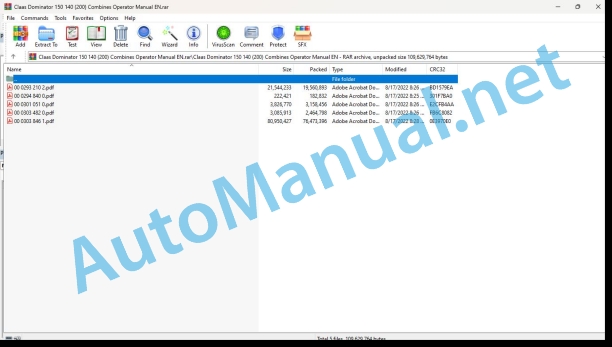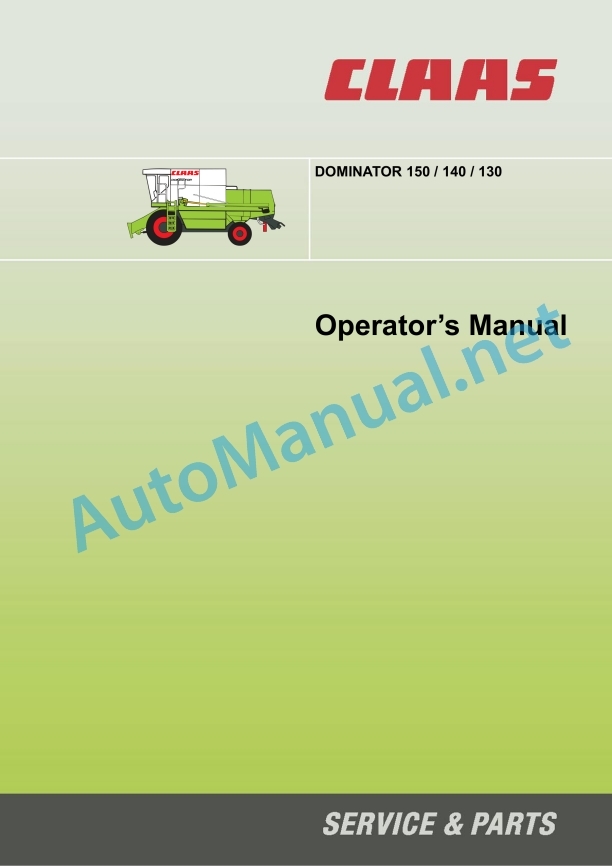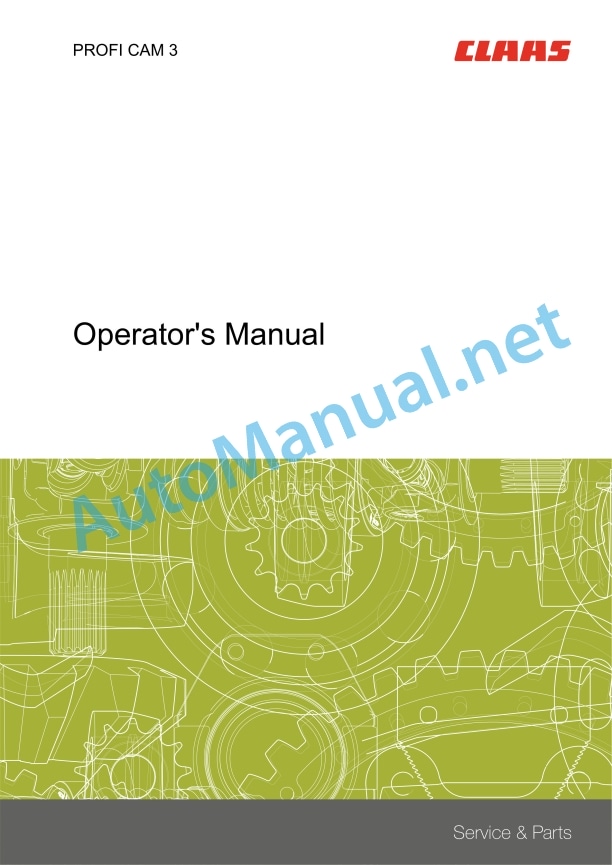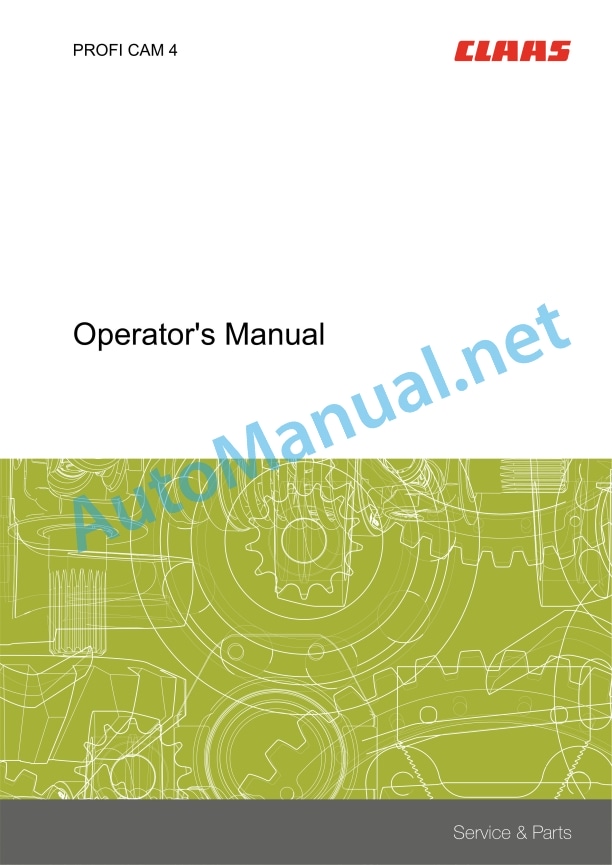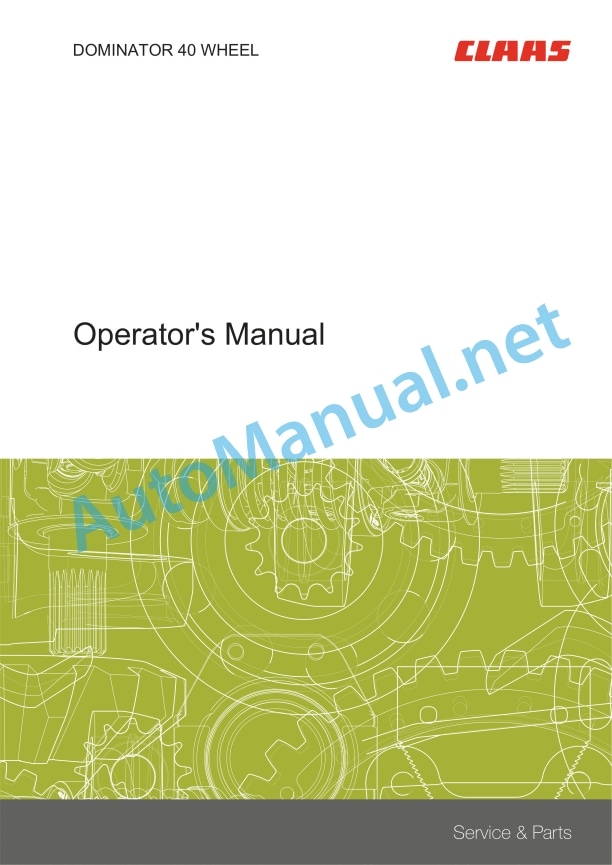Claas Dominator 150 140 (200) Combines Operator Manual EN
$50.00
- Model: Dominator 150 140 (200) Combines
- Type Of Manual: Operator Manual
- Language: EN
- Format: PDF(s)
- Size: 97.1 MB
File List:
00 0293 210 2.pdf
00 0294 840 0.pdf
00 0301 051 0.pdf
00 0303 482 0.pdf
00 0303 846 1.pdf
00 0293 210 2.pdf:
1 Introduction
1.1 General Information
1.1.1 How to use this manual
1.1.2 Validity of instructions
1.1.3 Specifications
1.1.4 Road traffic regulations
1.1.5 Note on electronic engine management
1.2 Various components / Machine body
1.2.1 Spare parts and technical questions
1.2.2 Machine identification plate
1.2.3 Identification plate of CATERPILLAR 3056 E engine
1.2.4 Identification plate of PERKINS 1006-6T engine
1.2.5 Identification plate of CATERPILLAR C6.6 engine
1.2.6 Drive axle identification plate
1.2.7 Rear axle identification plate
1.2.8 Trailer hitch identification plate
1.2.9 Hitch block identification plate
1.2.10 Cab identification plate
1.2.11 Straw chopper identification plate
2 Sectional view of machine
2.1 Attachment parts / machine body
2.1.1 Machine overview
2.1.2 Access to the workplace and maintenance areas
3.1 General Information
3.1.1 General information
3.1.2 Important information
3.1.3 Intended use
3.1.4 Reasonable foreseeable misuse
3.1.5 Safety and accident prevention regulations
3.1.6 General safety and accident prevention regulations for combine harvesters
3.1.7 Prior to operation, general
3.1.8 Additional weights
3.1.9 Transporting passengers
3.1.10 General driving operations
3.1.11 Automotive operation of combine harvester
3.1.12 Driving operations on slopes
3.1.13 Leaving the machine
3.1.14 Front attachments and trailers
3.1.15 Crop receptacle / straw receptacle
3.1.16 Grain delivery
3.1.17 Air conditioner
3.1.18 Adjustment and maintenance work
3.1.19 Accumulators
3.1.20 Antifreeze
3.1.21 First aid measures
3.1.22 Decommissioning and disposal
3.1.23 Applying the feeder housing safety lock
3.1.24 Moving out the feed rake conveyor safety lock
3.1.25 Secure the machine with wheel chocks so it will not roll away
3.1.26 Securing the straw guide apron in raised position
3.1.27 Jack up the machine
3.1.28 Fire extinguisher
3.1.29 Battery isolating switch
3.1.30 Danger of injury due to escaping hydraulic liquid
3.1.31 Loading and tying down the machine
3.1.32 Removing the lift eyes
3.2 Safety rules
3.2.1 Identification of warning and danger signs
3.3 Safety decals
3.3.1 General information on safety decals
3.3.2 Engine
3.3.3 Chassis
3.3.4 Cab / Operator’s platform
3.3.5 Feeder unit
3.3.6 Threshing mechanism
3.3.7 Separation
3.3.8 Crop receptacle / straw receptacle
3.3.9 Grain delivery
3.3.10 Various components / Machine body
3.4 Safety decals
3.4.1 General instructions on safety decals
3.4.2 Chassis
4 Specifications
4.1 DOMINATOR 150 / 140 / 130
4.1.1 General information
4.1.2 CATERPILLAR C6.6 engine
4.1.3 CATERPILLAR 3056E engine
4.1.4 Perkins 1006-T6 engine
4.1.5 Chassis
4.1.6 Tyre pressures
4.1.7 Chassis track width
4.1.8 Brake
4.1.9 Steering
4.1.10 Electric system / Electronics
4.1.11 Cab / Operator’s platform
4.1.12 Intake
4.1.13 Threshing mechanism
4.1.14 Separation
4.1.15 Cleaning unit
4.1.16 Grain delivery
4.1.17 Attachment parts / machine body dimensions
4.1.18 Attachment parts / machine body weights
5 Prior to initial operation
5.1 General Information
5.1.1 General warnings Prior to initial operation
5.1.2 Initial operation check list
5.2 Chassis
5.2.1 Removing / installing the wheels
5.2.2 Overview of rear axle
5.2.3 Converting the rear axle from transport to working position
5.2.4 Rear axle 00 0649 950 1 – Adjusting the track width
5.3.1 Installing the trailer hitch (accessories)
5.4 Electrical / electronic equipment
5.4.1 Installing the fan / air conditioner fuse
5.5 Feeder unit
5.5.1 Fitting / adjusting the mounting plates
5.5.2 Aligning the coupling pin
5.5.3 Checking the front attachment cylinders
5.5.4 Checking the cutterbar float springs
5.6 Grain delivery
5.6.1 Closing the service aperture on the grain tank unloading tube
5.6.2 Installing the grain tank safety device
6 Prior to each operation
6.1 General Information
6.1.1 General warnings Prior to operation
6.1.2 Check list for daily operation
7 Overview of controls
7.1 General Information
7.1.1 General warnings – Overview of controls
7.2 Cab / Operator’s platform
7.2.1 Overview of operator’s platform (DOMINATOR 130)
7.2.2 Overview of operator’s platform (DOMINATOR 150/140)
7.2.3 Hydraulic system control unit (DOMINATOR 130 lift hydraulic system)
7.2.4 Multifunction handle (DOMINATOR 150 / 140)
7.2.5 Switch console (DOMINATOR 130)
7.2.6 Diesel engine speed adjustment rotary switch (DOMINATOR 130, CATERPILLAR C-6.6, 3056 E)
7.2.7 Diesel engine speed lever (DOMINATOR 130, Perkins 1006-T6)
7.2.8 Function of warning lights 7 and 8 (DOMINATOR 130)
7.2.9 Switch console (DOMINATOR 150 / 140)
7.2.10 Diesel engine speed rotary switch (DOMINATOR 150 / 140)
7.2.11 Function of warning lights 15 and 18 (DOMINATOR 150 / 140)
7.2.12 Overview of steering column
7.2.13 Cab roof controls
7.2.14 Cab with fan
7.2.15 Cab with air conditioner (with York compressor)
7.2.16 Cab with air conditioner (with Sanden compressor)
7.2.17 Cab with fan and heater
7.2.18 Control levers
7.2.19 Functions monitor
7.3 Attachment parts / machine body
7.3.1 Worklights
7.3.3 Sun roof
7.3.4 Tool box
8 Mounting/removing front attachment
8.1 General Information
8.1.1 General warnings Installing / removing the front attachment
8.2 Installing the front attachment
8.2.1 Suspending front attachment
8.2.2 Interlocking the front attachment
8.2.3 Installing universal drive shaft
8.2.4 Connecting the hydraulic system
8.2.5 Connecting the electric equipment (accessory)
8.2.6 Removing the stands
8.3 Removing the front attachment
8.3.1 Fitting the stands
8.3.2 Disconnecting the hydraulic system
8.3.3 Disconnecting the electric equipment (accessory)
8.3.4 Removing universal drive shaft
8.3.5 Unlocking the front attachment
8.3.6 Unhitching front attachment
9 Driving and transportation
9.1 General Information
9.1.1 General warnings – Driving and transportation
9.1.2 Preparing road travel
9.1.3 Preparing fieldwork
9.2 Engine
9.2.1 Adjusting the diesel engine speed (DOMINATOR 150 / 140)
9.2.2 Starting the diesel engine (DOMINATOR 150 / 140)
9.2.3 Stopping the diesel engine (DOMINATOR 150 / 140)
9.2.4 Adjusting the diesel engine speed (DOMINATOR 130)
9.2.5 Starting the diesel engine (DOMINATOR 130)
9.2.6 Stopping the diesel engine (DOMINATOR 130)
9.3 Chassis
9.3.1 Ground speed control lever (DOMINATOR 150 / 140)
9.3.2 Shifting a gear (DOMINATOR 150 / 140)
9.3.3 Ground speed control lever (DOMINATOR 130)
9.3.4 Shifting a gear (DOMINATOR 130)
9.3.5 Adjusting the ground speed control lever actuating resistance (DOMINATOR 150 / 140)
9.3.6 Driving behaviour
9.3.7 Towing the machine
9.3.8 Forward towing
9.3.9 Reverse towing
9.4.1 Applying the parking brake
9.4.2 Releasing the parking brake
9.4.3 Foot brake
9.4.4 Braking / stopping the machine (DOMINATOR 150 / 140)
9.4.5 Braking / stopping the machine (DOMINATOR 130)
9.4.6 Parking the machine
9.5 Steering
9.5.1 Steering
9.5.2 Adjusting the steering column
9.6.1 Hitching the trailer
9.6.2 Unhitching the trailer
9.7 Cab / Operator’s platform
9.7.1 Adjusting the driver’s seat with mechanical suspension (standard version)
9.7.2 Adjusting the driver’s seat with mechanical suspension (standard version)
9.7.3 Adjusting the mechanically suspended driver’s seat (option)
9.8 Various components / Machine body
9.8.1 Rotating the front ladder (standard)
9.8.2 Adjusting the rear ladder
10 Fieldwork settings
10.1 General Information
10.1.1 General warnings – Fieldwork settings
10.2 Feeder unit
10.2.1 Adjusting the cutting height indicator
10.2.2 Adjusting the scraper profiles
10.2.3 Adjusting the height of the feeder chain
10.2.4 Adjusting the front attachment drop rate (DOMINATOR 150)
10.3 Threshing mechanism
10.3.1 Removing / installing threshing concave segments (Multicrop concave)
10.3.2 Adjusting the basic concave adjustment
10.4 Separation
10.4.1 Adjusting the separation performance monitor sensors
10.5 Cleaning unit
10.5.1 Checking / adjusting the fan speed display
10.5.2 Adjusting the cleaning performance monitor sensors
10.5.3 Removing the sieves
10.5.4 Installing the sieves
10.6 Crop receptacle / straw receptacle
10.6.1 Removing the straw guide plate (straw chopper with standard spreader)
10.6.2 Installing the straw guide plate (straw chopper with standard spreader)
10.6.3 Unscrewing the free-swinging knives
10.6.4 Bolting down the free-swinging knives
10.6.5 Straw chopper sieves installation position
10.7 Grain delivery
10.7.1 Adjusting the grain tank full indicator DOMINATOR 150
11 Fieldwork
11.1 General Information
11.1.1 General warnings Fieldwork
11.2 Description and function
11.2.1 Cutterbar
11.2.2 Threshing mechanism
11.2.3 Straw walker
11.2.4 Cleaning unit
11.2.5 Disawning
11.3 Considerations before combining
11.3.1 When combining, remember:
11.4 Front attachment
11.4.1 Adjusting the reel horizontally (mechanically)
11.4.2 Adjusting the reel horizontally (hydraulically)
11.4.3 Adjusting the reel circumferential speed
11.5 Feeder unit
11.5.1 Reading the ground pressure
11.5.2 Reading the cutting height
11.5.3 Reversing the front attachment / feeder unit
11.5.4 Switching on the front attachment
11.5.5 Disengaging the front attachment
11.6 Threshing mechanism
11.6.1 Engaging the threshing mechanism
11.6.2 Disengaging the threshing mechanism
11.6.3 Adjusting the concave
11.6.4 Installing / removing the disawner bars (accessory)
11.6.5 Unslugging the threshing drum
11.6.6 Adjusting the threshing drum speed
11.6.7 Threshing drum two-step variable- speed drive (chain drive)
11.7 Separation
11.7.1 Adjusting the deflector curtain
11.7.2 Observe the straw blockage warning downstream of the separation stage
11.7.3 Adjusting the separation performance monitor display
11.7.4 Installing / removing the straw walker fishback
11.8 Cleaning unit
11.8.1 Adjusting the fan speed
11.8.2 Adjusting the wind board
11.8.3 Adjusting the sieves manually
11.8.4 Adjusting the cleaning performance monitor display
11.9 Crop receptacle / straw receptacle
11.9.1 Putting the straw chopper into operation (swinging the standard spreader to chopping position)
11.9.2 Putting the straw chopper out of operation (swinging the standard spreader to swathing position)
11.9.3 Swinging the standard distributor into the transport trolley transport position
11.9.4 Adjusting the stationary knives (standard straw chopper)
11.10 Grain delivery
11.10.1 Inspecting the returns
11.10.2 Opening / closing the grain tank cover
11.10.3 Swinging the grain tank unloading tube out / in (DOMINATOR 150 / 140)
11.10.4 Swinging the grain tank unloading tube out / in (DOMINATOR 130)
11.10.5 Engaging / disengaging the grain tank unloading
11.10.6 Removing / installing the grain tank auger cover plates
11.10.7 Clean machine for bulk seed change
11.11 Sieve charts / threshing charts
11.11.1 Sieve table
11.11.2 Threshing table
11.12 Disawning
11.12.1 Disawner bars
12 Faults and remedies
12.1 General Information
12.1.1 General warnings Faults and remedy
12.2 Cab / Operator’s platform
12.2.1 Central terminal compartment
12.2.2 Air conditioner faults and remedies
12.3 Front attachment
12.3.1 Front attachment
12.4 Feeder unit
12.4.1 Feeder unit problem and remedy
12.5 Threshing mechanism
12.5.1 Threshing mechanism problem and remedy
12.5.2 Threshing drum
12.6 Separation
12.6.1 Separation problem and remedy
12.7 Cleaning unit
12.7.1 Cleaning problem and remedy
12.8 Crop receptacle / straw receptacle
12.8.1 Crop / straw discharge problems and remedies
12.9 Grain delivery
12.9.1 Grain delivery problems and remedies
12.9.2 Installing the grain tank unloading shear bolt
13 Maintenance
13.1 General Information
13.1.1 General warnings Maintenance
13.2 General Information
13.2.1 Front attachment
13.2.2 Cleaning the engine compartment and hazard areas
13.2.3 Belts
13.2.4 Variable-speed drives
13.2.5 Bolts
13.2.6 Lubrication
13.2.7 Cleanliness of lubricants
13.2.8 Brakes
13.2.9 Wheels / tyres
13.2.10 Hydraulic system
13.2.11 Electrical system
13.2.12 Air conditioner
13.2.13 Protective guards
13.2.14 Spare parts
13.2.15 Unbalance
13.2.16 Welding work on combine harvester
13.2.17 Putting the machine out of action
13.2.18 Cleaning of surfaces with decals applied
13.2.19 Winter storage instructions for combines
13.2.20 Coolant
13.3 Maintenance schedule
13.3.1 Service intervals
13.4 Lubricants chart
13.4.1 Lubricants
13.5 Engine
13.5.1 Overview of engine CATERPILLAR C-6.6
13.5.2 Overview of engine CATERPILLAR 3056 E
13.5.3 Overview of engine PERKINS 1006-6T
13.5.4 Overview of cooling units
13.5.5 Cleaning the diesel engine surroundings
13.5.6 Draining fuel from the fuel tank
13.5.7 Fill up the machine’s fuel tank
13.5.8 Cleaning the fuel tank filler screen
13.5.9 Closing / opening the fuel system shut- off tap
13.5.10 Bleed fuel system
13.5.11 Cleaning the fuel sediment bowl filter
13.5.12 Draining condensation at the fuel prefilter (standard equipment)
13.5.13 Changing the fuel prefilter (standard equipment)
13.5.14 Draining condensation at the fuel prefilter (additional equipment)
13.5.15 Changing the fuel pre-filter (accessory)
13.5.16 Changing the fuel filter CATERPILLAR C-6.6 / 3056 E
13.5.17 Changing the fuel filter PERKINS 1006-6T
13.5.18 Checking the diesel engine oil level
13.5.19 Changing the diesel engine oil / oil filter
13.5.20 Adjusting the diesel engine valves
13.5.21 Checking the radiator coolant level
13.5.22 Checking the coolant mixing ratio
13.5.23 Changing the radiator coolant
13.5.24 Draining the radiator coolant
13.5.25 Topping up coolant
13.5.26 Cleaning the rotary chaff screen
13.5.27 Cleaning the cooling unit
13.5.28 Changing the coolant hoses
13.5.29 Cleaning / changing the diesel engine air cleaner with plastic housing
13.5.30 Changing the diesel engine air cleaner safety cartridge with plastic housing
13.5.31 Cleaning the air filter intake screen
13.5.32 Changing the air intake hoses
13.5.33 Retightening the air intake tube clamps
13.6 Chassis
13.6.1 Wheels / tyres
13.6.2 Checking the tightening torque of wheel nuts / wheel bolts
13.6.3 Cleaning the surroundings of the drive axle manual gearbox
13.6.4 Checking the final drive oil level DOMINATOR 150 / 140
13.6.5 Draining the final drive oil DOMINATOR 150 / 140
13.6.6 Topping up the final drive oil DOMINATOR 150 / 140
13.6.7 Checking the final drive oil level DOMINATOR 130
13.6.8 Draining the final drive oil DOMINATOR 130
13.6.9 Topping up the final drive oil DOMINATOR 130
13.6.10 Checking the drive axle gearbox oil level
13.6.11 Draining the oil from the drive axle gearbox
13.6.12 Topping up oil in the drive axle gearbox
13.6.13 Adjusting the chassis clutch DOMINATOR 130
13.6.14 Adjusting the short-circuit valve DOMINATOR 130
13.7 Brake
13.7.1 Checking / refilling brake fluid
13.7.2 Adjusting the parking brake
13.7.3 Adjusting the foot brake
13.8 Drive belts / drive chains
13.8.1 General warnings
13.8.2 Drive diagram, left side DOMINATOR 150 / 140 / 130
13.8.3 Drive diagram, right side DOMINATOR 150 / 140 / 130
13.8.4 Adjusting belt (R1)
13.8.5 Adjusting belt (R2)
13.8.6 Adjusting belt (R3)
13.8.7 Adjusting belt (R4)
13.8.8 Adjusting belt (R5)
13.8.9 Adjusting belt (R8)
13.8.10 Adjusting belt (R9)
13.8.11 Adjusting belt (R10)
13.8.12 Removing belt (R7)
13.8.13 Installing belt (R7)
13.8.14 Adjusting belt (R12)
13.8.15 Adjusting belt (R13)
13.8.16 Removing belt (R14)
13.8.17 Installing belt (R14)
13.8.18 Adjusting belt (R14)
13.8.19 Removing belt (R42)
13.8.20 Installing belt (R42)
13.9 Hydraulic system
13.9.1 Checking the hydraulic system oil level
13.9.2 Changing the hydraulic system oil / oil filter / fresh air filter element DOMINATOR 150 / 140
13.9.3 Changing the hydraulic system oil / oil filter / fresh air filter element DOMINATOR 130
13.10 Electric system / Electronics
13.10.1 Checking the battery electrolyte level
13.11 Cab / Operator’s platform
13.11.1 Cleaning / changing the cab air filter
13.11.2 Cleaning the cab recirculation air filter
13.11.3 Cleaning the cab roof units
13.11.4 Putting the air conditioner into operation
13.11.5 Precautions for protecting the air conditioner during extended standstill periods – DOMINATOR 130 with York compressor
13.11.6 Checking the air conditioner refrigerant moisture saturation
13.11.7 Changing the air conditioner refrigerant
13.12 Feeder unit
13.12.1 Cleaning the feed rake conveyor retainers
13.12.2 Adjusting the feeder chains
13.12.3 Adjusting the feeder chain slip clutch
13.12.4 Checking the rasp plates on the feed rake conveyor
13.13 Threshing mechanism
13.13.1 Cleaning the stone trap
13.13.2 Cleaning the threshing mechanism
13.14 Separation
13.14.1 Cleaning the straw walker
13.14.2 Checking the deflector curtain
13.14.3 Cleaning the separation throughput monitor sensor
13.15 Cleaning unit
13.15.1 Cleaning the cleaning throughput monitor sensor
13.15.2 Cleaning the fan
13.15.3 Setting the fan speed gauge
13.15.4 Cleaning the stepped preparation floors
13.15.5 Cleaning the sieves
13.16 Grain delivery
13.16.1 Adjusting the returns elevator chain
13.16.2 Adjusting the grain elevator chain
13.16.3 Cleaning the auger troughs
13.16.4 Cleaning the grain tank
13.16.5 Adjusting the grain tank unloading tube support transport position
13.17 Various components / Machine body
13.17.1 Checking the fire extinguisher
14 Lubrication chart
14.1 Lubrication points
14.1.1 General warnings Lubrication chart
14.1.2 Lubricants
14.1.3 Greasing cycles
14.1.4 Lubrication points – 10 h on the left
14.1.5 Lubrication points – 10 h on the right
14.1.6 Lubrication points – 50 h on the left
14.1.7 Lubrication points – 50 h on the right
14.1.8 Lubrication points – 100 h on the left
14.1.9 Lubrication points – 100 h on the right
14.1.10 Lubrication points – 500 h on the left
14.1.11 Lubrication points – 500 h on the right
00 0301 051 0.pdf:
PROFI CAM 3
Table of contents
1 Introduction
1.1 Notes on the manual
1.1.1 Validity of manual
1.1.2 Information about this Operator’s Manual
1.1.3 Symbols and notes
1.1.4 Optional equipment
1.1.5 Qualified specialist workshop
1.1.6 Maintenance information
1.1.7 Warranty notes
1.1.8 Spare parts and technical questions
1.2 Intended use
1.2.1 Intended use
1.2.2 Reasonably foreseeable misuse
2.1 Identifying warnings
2.1.1 Hazard signs
2.1.2 Signal word
2.2 Safety rules
2.2.1 Meaning of Operator’s Manual
2.2.2 Observing safety decals and warnings
2.2.3 Optional equipment and spare parts
3 Product description
3.1 Overview and method of operation
3.1.1 How the PROFI CAM works
3.2 Identification plates and identification number
3.2.1 Position of identification plates
3.2.2 Explanation of PROFI CAM identification plate
3.3 Information on the product
3.3.1 CE marking
4 Operating and control elements
4.1 Camera system
4.1.1 Camera system monitor
4.2 Menu structure
4.2.1 Main menu
4.2.2
4.2.3
4.2.4
4.2.5
4.2.6
5 Technical specifications
5.1 PROFI CAM
5.1.1 Monitor
5.1.2 Camera
5.1.3 Switch box
5.1.4 Degree of protection against foreign bodies and water
6 Preparing the product
6.1 Shutting down and securing the machine
6.1.1 Switching off and securing the machine
6.2 Prior to operation
6.2.1 Carry out prior to operation
6.2.2 Installing the sun protection
6.2.3 Aligning the camera
6.2.4 Connecting the camera electrics
7 Operation
7.1 Monitor
7.1.1 Switching on the monitor
7.1.2 Calling up the menu
7.1.3 Setting a menu item
7.1.4 Setting the image orientation
7.1.5 Setting automatic screen darkening
7.1.6 Image mirroring
7.1.7 Setting the trigger view
7.1.8 Setting the follow-up time for trigger view
7.1.9 Setting the display mode
7.1.10 Activating/deactivating a display mode
8 Faults and remedies
8.1 Electrical and electronic system
8.1.1 Overview of problems on PROFI CAM camera system
8.1.2 Replacing the switch box fuse
9 Maintenance
9.1 Maintenance intervals
9.1.1 Every 10 operating hours or daily
9.2 Camera system
9.2.1 Checking the camera system for dirt
9.2.2 Cleaning the camera
9.2.3 Cleaning the switch box
9.2.4 Cleaning the monitor
10 Placing out of operation and disposal
10.1 General Information
10.1.1 Putting out of operation and disposal
11 Technical terms and abbreviations
11.1 Abbreviations
11.1.1 Units
11.1.2 Abbreviations
11.1.3 Technical terms
00 0303 482 0.pdf:
PROFI CAM 4
Table of contents
1 Introduction
1.1 Notes on the manual
1.1.1 Validity of manual
1.1.2 Information about this Operator’s Manual
1.1.3 Symbols and notes
1.1.4 Optional equipment
1.1.5 Qualified specialist workshop
1.1.6 Maintenance information
1.1.7 Notes on warranty
1.1.8 Spare parts and technical questions
1.2 Intended use
1.2.1 Intended use
1.2.2 Reasonably foreseeable misuse
2.1 Identifying warnings
2.1.1 Hazard signs
2.1.2 Signal word
2.2 Safety rules
2.2.1 Meaning of Operator’s Manual
2.2.2 Structural changes
2.2.3 Optional equipment and spare parts
2.2.4 Operation only following proper putting into operation
2.2.5 Technical status
2.2.6 Respecting technical limit values
Respecting technical limit values
2.2.7 Hazards when driving on roads and fields
3 Product description
3.1 Overview and method of operation
3.1.1 How the PROFI CAM works
3.2 Identification plates and identification number
3.2.1 Identification plates
3.3 Information on the product
3.3.1 CE marking
4 Operating and display elements
4.1 Camera system
4.1.1 Camera system monitor
4.1.2 CEBIS
4.2 Menu structure
4.2.1 Main menu
4.2.2
4.2.3
4.2.4
4.2.5
4.2.6
5 Technical specifications
5.1 PROFI CAM
5.1.1 Monitor
5.1.2 Camera
5.1.3 Switch box
6 Preparing the product
6.1 Switching off and securing the machine
6.1.1 Switching off and securing the machine
6.2 Prior to putting into operation
6.2.1 Carry out prior to operation
6.2.2 Installing the sun protection
6.2.3 Aligning the camera
7 Operation
7.1 Monitor
7.1.1 Switching on the monitor
7.1.2 Calling up the menu
7.1.3 Setting a menu item
7.1.4 Setting the image orientation
7.1.5 Setting automatic screen darkening
7.1.6 Image mirroring
7.1.7 Setting the trigger view
7.1.8 Setting the follow-up time for trigger view
7.1.9 Setting the display mode
7.1.10 Activating/deactivating a display mode
8 Faults and remedies
8.1 Electric and electronic system
8.1.1 Overview of problems on PROFI CAM camera system
9 Maintenance
9.1 Maintenance intervals
9.1.1 Every 10 operating hours or daily
9.2 Camera system
9.2.1 Checking the camera system for dirt
9.2.2 Cleaning the camera
9.2.3 Cleaning the switch box
9.2.4 Cleaning the monitor
10 Putting out of operation and disposal
10.1 General information
10.1.1 Putting out of operation and disposal
11 Technical terms and abbreviations
11.1 Abbreviations
11.1.1 Units
11.1.2 Abbreviations
11.1.3 Technical terms
00 0303 846 1.pdf:
DOMINATOR 40 WHEEL
Table of contents
1 To this Operator’s Manual
1.1 Notes on the manual
1.1.1 Validity of manual
1.1.2 Notes on the Operator’s Manual
1.1.3 Symbols and notices
1.1.4 Optional equipment
1.1.5 Qualified specialist workshop
1.1.6 Notes on maintenance
1.1.7 Notes on warranty
1.1.8 Technical specifications
1.1.9 Spare parts and technical questions
2.1 Intended use
2.1.1 Intended use
2.1.2 Reasonably foreseeable misuse
2.2 Safety rules
2.2.1 Operator’s Manual and other sources of information
Meaning of Operator’s Manual
2.2.2 Personnel qualification and organization
Requirements made on all persons working with the machine
2.2.3 Hazard for children
Children in danger
2.2.4 Modifications on the machine
Structural modifications
2.2.5 Additional equipment and spare parts
Additional equipment and spare parts
2.2.6 Workplace and persons travelling on the machine
Control of running machine
2.2.7 Technically flawless condition
Operation only following proper pre-delivery inspection
Operation only following proper putting into operation
Technically flawless condition of machine
Danger from damage on the machine
Respecting technical limit values
2.2.8 Hazard areas
Hazard areas
Standing between machine and front attachment
Objects flying away
Hazard while drive is engaged
Risk of injury on the universal drive shaft
Hazard from machine parts that continue rotating
2.2.9 Safety devices
Keeping the safety devices functional
2.2.10 Personal protective equipment
Personal protective equipment
Wearing suitable clothing
2.2.11 Safety markings
Keeping safety decals legible
2.2.12 Road safety
Hazards when driving on the road and on the field
Danger of tipping
Preparing the machine for road travel
Parking the machine safely
Unsupervised parking
Keeping the machine free of foreign objects
2.2.13 Operating utilities
Unsuitable operating utilities
Safe handling of operating and auxiliary utilities
Fuel is hazardous to your health
Environmental protection and disposal
2.2.14 Hazards caused by the field environment
Fire hazard
Possibly lethal electrocution from overhead lines
Behaviour in case of voltage flash-over of overhead lines and in case of lightning strike
2.2.15 Hazard sources on the machine
Electrocution from electric system
Noise may cause health problems
Vibrations may cause health problems
Liquids under pressure
Toxic exhaust gas
Hot surfaces
2.2.16 Hazard when climbing on and leaving the machine
Safe climbing on and leaving the machine
2.2.17 Hazards when working on the machine
Working on machine only after shutting it down
Maintenance and repair work
Lifted machine parts and loads
Danger from welding work
2.2.18 Checking the battery
Checking and charging the battery
2.3 Safety instructions in this manual
2.3.1 Identification of warning and danger signs
2.4 Safety decals on the machine
2.4.1 Front attachment
2.4.2 Notes on safety decals
2.4.3 Safety decals of engine
2.4.4 Safety decals of chassis
2.4.5 Safety decals of hydraulic system
2.4.6 Safety decals on operator’s platform
2.4.7 Safety decals of feed rake conveyor
2.4.8 Safety decals of crop discharge and straw discharge
2.4.9 Safety decals of grain delivery
2.4.10 Drives
2.5 Safety devices
2.5.1 Applying the feed rake conveyor safety lock
2.5.2 Releasing the feed rake conveyor safety lock
2.5.3 Securing the machine against rolling away
2.5.4 Switching the battery isolating switch on and off
2.5.5 Checking the fire extinguisher
3 Machine description
3.1 Overview and method of operation
3.1.1 Overview of DOMINATOR 40 Wheel, front and left
3.1.2 Overview of rear and right side of machine
3.1.3 Overview of front attachment
3.1.4 Working mode of the machine
3.1.5 Function of machine
3.1.6 Engine overview Ashok Leyland H3C4E7422
3.1.7 Overview of cooling units
3.2 Identification plates and vehicle identification number
3.2.1 Machine identification plate
Identification plate
4 Operating and control elements
4.1 Operator’s platform
4.1.1 Operator’s platform
4.1.2 Switch console and display panel
4.1.3 Drive lights, work lights, mirrors
4.1.4 Control levers
4.1.5 Lever for adjusting the diesel engine speed
4.1.6 Ignition switch
4.1.7 Steering column controls
4.1.8 Driver���s seat
5 Technical specifications
5.1 DOMINATOR 40 Wheel – type 551
5.1.1 Ashok Leyland H3C4E7422 diesel engine
5.1.2 Chassis
5.1.3 Chassis wheel tread
5.1.4 Tyre Pressure
5.1.5 Clearance circle diameter
5.1.6 Turning circle diameter
5.1.7 Brake
5.1.8 Steering
5.1.9 Electric and electronic equipment
5.1.10 Sound pressure level and vibrations
5.1.11 Feed rake conveyor
5.1.12 Threshing mechanism
5.1.13 Separation unit
5.1.14 Cleaning unit
5.1.15 Grain tank capacity
5.1.16 Dimensions of grain tank unloading tube in working position
5.1.17achine dimensions
5.1.18 Weights
6 Machine preparation
6.1 Switching off and securing the machine
6.1.1 Switch off and secure the machine
6.2 Accerkplaces and maintenance places
6.2.1 Remove the front ladder
6.2.2 Adjusting the rear ladder
ccess to the workplace and maintenance areas
6.3 Prior to putting into operation
6.3.1 Prior to initial operation
6.4 Setting of the machine for the operation
6.4.1 Setting the machine to grain harvest
6.4.2 Sieve chart
6.4.3 Threshing chart
6.4.4 Clean the machine for harvesting seeds
6.5 Diesel engine
6.5.1 Refuelling
6.6 Chassis
6.6.1 Removing and installing the wheels
6.6.2 Jacking up the machine
6.7.1 Checking the parking brake
6.7.2 Checking the foot brake
6.8 Hydraulic system
6.8.1 Identifying the hydraulic oil
6.9 Operator’s platform
6.9.1 Installing rear view mirrors
6.10 Feeder unit
6.10.1 Adjusting the feeder chain height
6.11 Threshing mechanism
6.11.1 Opening and closing the stone trap
6.11.2 Opening and closing the drum inspection cover
6.11.3 Checking the basic threshing concave setting
6.11.4 Installing or removing the disawner bars*
6.12 Separation
6.12.1 Removing and installing the deflector curtain
6.12.2 Installing and removing side risers
6.12.3 Installing and removing centre risers
6.13 Cleaning system
6.13.1 Removing the sieves
6.13.2 Installing the sieves
6.13.3 Assembly of Straw Walker
6.14 Grain delivery
6.14.1 Entering and leaving the grain tank
Entering and leaving the straw walker compartment
6.14.2 Adjusting the grain tank auger cover plates
6.14.3 Closing the service flap on the grain tank unloading tube
6.15 Assembly parts and bodywork
6.15.1 Opening / closing the side panels
6.15.2 Checking the reverse warning horn
7 Operation
7.1 Driving the machine
John Deere Repair Technical Manual PDF
John Deere Repair Technical Manual PDF
John Deere Repair Technical Manual PDF
John Deere Diesel Engines PowerTech 4.5L and 6.8L – Motor Base Technical Manual 07MAY08 Portuguese
John Deere Repair Technical Manual PDF
John Deere Repair Technical Manual PDF
John Deere Parts Catalog PDF
John Deere Tractors 7500 Parts Catalog CPCQ26568 30 Jan 02 Portuguese
John Deere Repair Technical Manual PDF
John Deere DF Series 150 and 250 Transmissions (ANALOG) Component Technical Manual CTM147 05JUN98
John Deere Repair Technical Manual PDF
John Deere Diesel Engines POWERTECH 2.9 L Component Technical Manual CTM126 Spanish
John Deere Repair Technical Manual PDF
John Deere 16, 18, 20 and 24HP Onan Engines Component Technical Manual CTM2 (19APR90)

